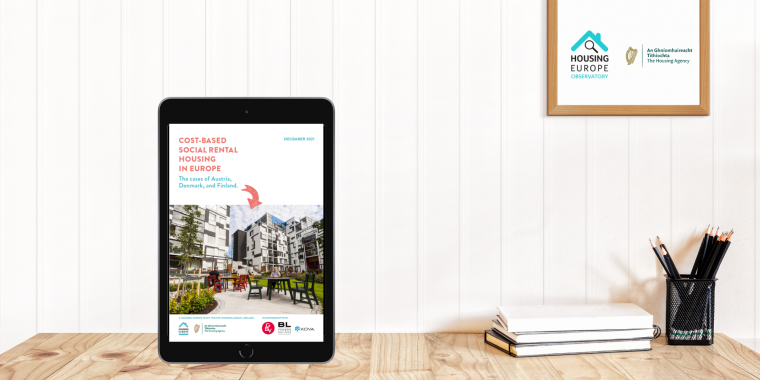Cost-based social rental housing in Europe
A new report by the Housing Europe Observatory outlines the cases of Austria, Denmark, and Finland
Online, 13 December 2021 | Published in Economy, Future of the EU & Housing
Cost-based social rental housing is a success story. It has helped those social providers who make use of this model of rent setting — such as in Austria, Denmark, and Finland — to better ensure their long-term capacity to develop new affordable housing and meet unexpected investment needs, such as renovations or engaging with the necessary energy transition. This research was commissioned and funded by The Housing Agency, Ireland and led by the Housing Europe Observatory.
Funding structures for the delivery, maintenance and renovation of social housing in Europe are extremely varied. In some instances, housing provision relies almost exclusively on direct funding — like grants or loans — from national or local governments or public agencies. In other instances, providers have significantly more diversified sources of funding; making use of not only public funds, but also private sources of finance. At the same time, so-called ‘own resources’ (e.g., a housing provider’s own ‘savings’ generated from operating surpluses or the sale of assets) can form an important part of the required capital funding for social housing projects.
Where exactly a given social housing system falls on the rough spectrum of ‘highly reliant on public funds’ for affordable housing development to ‘makes use of highly diversified funding sources’ seems to depend on a number of factors, many of which are dictated by the history and attitudes towards the idea of ‘housing as a public good’ in a given country or region. At the same time, one crucial factor in determining the ‘mix’ of funding for social housing development seems to be the mechanism by which the rents paid by social tenants are set.
Broadly speaking, there are four main ways that social rents can be determined[1].
Income-based: rents can be set relative to the assessed means to pay of an individual household. This means that the rent paid by a household might not be sufficient to cover the costs of actually providing the home.
Market-based: rents can be set relative to ‘market’ rents. For example, the social rent could be set at a fixed percentage of the rent that the home would cost if it were rented on the private market.
Utility-based: rent is set in relation to the characteristics of the home. This could include such characteristics as size, location, orientation, and available amenities.
Cost-based: rent can be set at a level which allows the social provider to meet the costs of provision, e.g., repayment of loans/subsidies, maintenance, insurance.
In practice, the rent setting mechanism in a given country or region is likely to be some mix of the four options listed above, or a so-called ‘hybrid’ rent setting system.
The focus of this report will be the case-study countries of Austria, Denmark, and Finland; which arguably provide the best examples of large-scale, cost-based social rental systems in Europe.
The overall ambition of this report is to outline the ‘mechanics’ of the rent-setting and financing systems in these three countries. This will help others to better understand their cost-based social housing models, and potentially serve to promote such systems as a possible way to reimagine or restructure their own methods of affordable housing provision. However, it should be noted that despite all three case-study countries using a cost-based system of social rent setting, there are several important differences between them in terms of how this is structured and applied in practice. These differences will be outlined and discussed in the proceeding sections of the report.
In a an article by the Irish Business Post, our Research Coordinator and co-author of the report, Dara Turnbull emphasises that 'the key takeaway from the research for the Housing Agency is that the cost rental model will only have an effect on rental affordability in Ireland if it is properly planned and developed to a large scale over the long term.' He suggests that Ireland should pursue the “closed loop” public housing system, like other continental European countries, which would in turn help provide ongoing affordable housing. “In Ireland, when we were selling social housing in the 1980s and 1990s, that was the complete antithesis of the closed loop idea that pervades Austria, Finland and Denmark,” he said.' To the article.